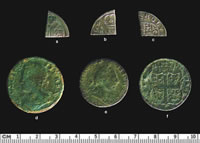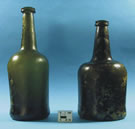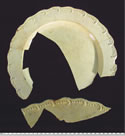Artifacts

One means of gaining insight into the daily lives and behavior of enslaved African-Americans is through the study of their material culture. The analysis of ceramics, glass, and food remains (faunal [animal] and floral [plant]) can provide clues about socioeconomic status, diet, and refuse disposal patterns of households and communities over time.

The excavation of 135 test units, 129 features, and one trench at Site 44JC969 resulted in the recovery of 14,382 historic artifacts and 155 prehistoric artifacts. Historic artifacts include 117 from general surface and block spoil contexts, 19 from the trench excavation context, 3,490 from feature contexts, and 10,774 from test unit excavations. Handmade brick, daub, mortar, oyster shell, and fossilized shell, were weighed rather than counted.
In addition to the weighed items described above, the artifact assemblage includes artifacts related to food preparation/consumption (58%), architecture (29%), unassigned material (6%), smoking (5%), floral/faunal material (2%), and medicinal/hygiene (1%).  The remaining artifacts are related to clothing, arms and military, activities, personal, domestic attributes, and furniture—each category accounting for less than 1% of the total artifact assemblage.
The remaining artifacts are related to clothing, arms and military, activities, personal, domestic attributes, and furniture—each category accounting for less than 1% of the total artifact assemblage.
Interpretations of the artifacts as well as photos of selected artifacts from Site 44JC969 are available.
|
Group |
Total |
|
Food prep/consumption |
8303 |
|
Architectural |
3897 |
|
Furniture |
8 |
|
Arms/military |
84 |
|
Clothing |
100 |
|
Personal |
15 |
|
Medicine/hygiene |
192 |
|
Domestic attributes |
9 |
|
Activities |
25 |
|
Smoking |
659 |
|
Unassigned material |
814 |
|
Faunal/floral |
276 |
|
TOTAL HISTORIC |
14382 |
|
Shell (kg) |
3.7 |
|
Fossil Shell (g) |
37.3 |
|
Handmade Brick (kg) |
288.1 |
|
Daub (g) |
61.7 |
|
Mortar (g) |
114.3 |














